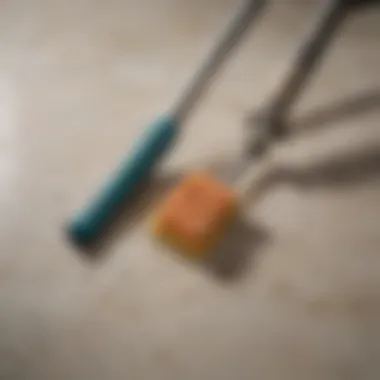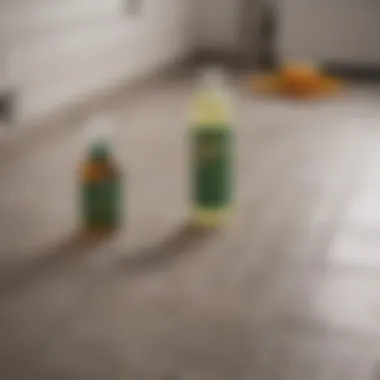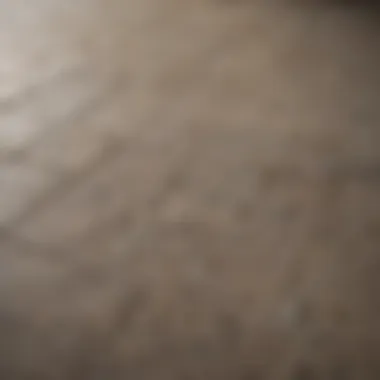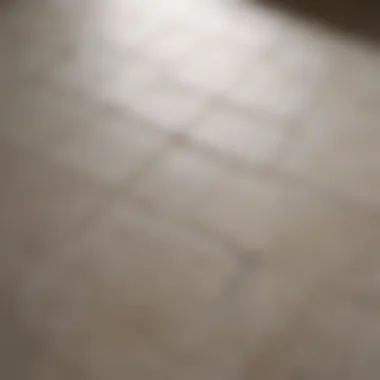Best Methods to Clean Grout: A Comprehensive Guide


Intro
Grout often becomes a silent witness to the wear and tear of our daily lives, accumulating stains, dirt, and grime in the crevices between tiles. The importance of clean grout extends beyond aesthetics. Clean grout promotes hygiene and reduces the risk of mold and mildew. This guide aims to present methods to effectively clean grout, providing insights into practical solutions suited for various cleaning preferences. From chemical formulations to eco-friendly alternatives, there's a strategy for everyone.
It's essential to understand the nature of grout itself. Typically composed of a mixture of cement, water, and sometimes sand, grout is porous. This porosity allows it to absorb dirt and liquids, making it susceptible to staining. Hence, proactive cleanup methods are necessary to maintain its appearance and functionality.
As we navigate through this comprehensive guide, a variety of techniques will be discussed. Each method varies in complexity, effectiveness, and suitability for different situations. This helps even those less familiar with cleaning strategies to achieve their desired results. Let’s delve deeper into these methods.
Understanding Grout
Understanding grout is basic for anyone looking to maintain the cleanliness and appearance of tiled surfaces. Grout serves a practical function, filling the spaces between tiles and ultimately supporting the structure of the flooring or wall system. It not only ensures stability but contributes to the aesthetic appeal of the design.
In this section, we will explore several aspects of grout, its different forms, and common issues that people face. Recognizing the type of grout used, along with its properties, allows for better cleaning methods. Additionally, understanding grout can guide individuals in making informed choices regarding maintenance and cleaning products.
What is Grout?
Grout is a mixture used to fill the gaps between tiles. It typically consists of water, cement, and aggregate. By solidifying, grout keeps tiles settled in place and seals any gaps. A well-applied grout line is vital for both appearance and function. Without it, dirt, moisture, and bacteria can build up, leading to bigger issues over time.
Types of Grout
Grout comes in several varieties, each designed for specific applications. Knowing the different types helps in selecting the right method for cleaning.
Cementitious Grout
Cementitious grout is the most common type. It is mainly made of cement, water, and sand. This kind of grout is often a popular choice due to its affordability and ease of use. It is porous, which means it can absorb water and stains. This necessitates more frequent cleaning and sealing to maintain its appearance and integrity.
Epoxy Grout
Epoxy grout is composed of epoxy resins and hardeners, making it more durable than cementitious options. It is water-resistant and less porous, which helps to prevent staining and mold growth. This type of grout is often preferred for high-moisture areas like bathrooms. However, it can be more expensive and requires specific techniques for application and removal.
Organic Grout
Organic grout uses natural materials like plant fibers or compounds. This type is less common and is typically used in specific situations where environmental factors are considered. While it may provide certain benefits to the ecological aspect, organic grout can be less durable and may require special maintenance practices.
Common Grout Issues
Grout can develop several common issues that directly affect its appearance and functionality.
Mold Growth
Mold growth is a significant concern for grout, especially in humid environments. Mold thrives in damp conditions, and grouted areas in bathrooms or kitchens may become breeding grounds. Mold not only looks bad but can also pose health risks, making it essential to address this issue quickly.
Staining
Stains result from spills, dirt, and wear over time. Porous grout may absorb these substances, leading to discoloration. Cleaning stains promptly is crucial to maintaining the grout's appearance. If stains set in, they can become difficult to remove, complicating cleaning efforts.
Cracking
Cracking occurs when grout is subjected to pressure or significant temperature changes. This can undermine the stability of the tiles and may require re-grouting. Cracks not only affect the look of the grout but can also lead to peeling or chipping of tiles, causing further damage.
Summary: Understanding grout types and issues is vital in maintaining tile surfaces effectively. Knowing these elements contributes to informed cleaning and maintenance routines. This ensures the longevity and aesthetic appeal of tiled spaces.
Factors That Affect Grout Cleaning
When it comes to cleaning grout, several factors play a critical role in determining the effectiveness of the cleaning process. Recognizing these factors can significantly influence the choice of method and product used, ultimately affecting the results achieved. It is essential to consider the age and condition of grout, the type of tile it complements, and the specific usage and environmental conditions. Each of these elements contributes uniquely to grout maintenance and cleanliness.
Age and Condition of Grout
The age and condition of grout can largely dictate the level of care required. Older grout is often more porous and may have accumulated more dirt, mold, and stains over time. This age also often correlates with a greater deterioration of the grout material itself, which could lead to cracking or loss of sealing properties.
Furthermore, grout that has not been properly maintained may prove more resistant to standard cleaning methods. Understanding these characteristics can help homeowners decide if they require a more intensive cleaning approach. If the grout is in notably poor condition, it might be worthwhile to consider professional restoration services or even complete re-grouting for a long-term solution.
Type of Tile
The type of tile accompanying the grout also significantly affects cleaning methods. Different materials react differently to various chemicals and cleaning techniques. For example, ceramic tiles are typically more resilient than natural stone tiles, which can be more sensitive to acidic cleaning solutions.


Using the wrong method on the wrong tile type can lead to damage, discoloration, or dulling of the surface. Therefore, knowledge about the specific tiles in your space is paramount. Always check the manufacturer's recommendations for both the tiles and the grout used, ensuring that the cleaning solution is compatible.
Usage and Environment
High Traffic Areas
High traffic areas, such as hallways or kitchen floors, experience more wear and tear. The accumulation of dirt, foot traffic, and spills can lead to excessive staining and grime on grout lines. The frequent movement in these areas means that they require more regular cleaning to maintain their appearance and hygiene.
In these settings, using durable cleaning tools and methods has its advantages, ensuring greater efficiency. However, it's crucial to select a cleaning method that is not overly abrasive, as repeated harsh cleaning can damage both the grout and the tiles.
Areas of Moisture
Areas of moisture, such as bathrooms and kitchens, are notoriously prone to mold and mildew growth. The humid environment can exacerbate existing problems in grout, leading to persistent stains, health hazards, and odors.
While cleaning is essential, preventing the growth of mold should be a priority in these areas. Regular maintenance through effective ventilation and moisture control should complement cleaning efforts. Areas with higher moisture levels may require more aggressive methods and frequent inspections to keep grout lines clean and maintain a healthy environment.
Chemical Cleaners
Chemical cleaners offer powerful solutions for grout cleaning. They can effectively tackle stubborn stains, mold, and grime that accumulate in shower tiles and kitchen backsplashes. Their potency is one of the main reasons many people choose them over natural alternatives. However, it is essential to approach these products with caution. The ingredients in chemical cleaners can sometimes be harsh, potentially damaging the grout itself or the surrounding surfaces.
Given their effectiveness, understanding the different types of chemical cleaners is vital for anyone looking to maintain clean grout. Each type serves a specific purpose and comes with its benefits and considerations. By selecting the right product, one can enhance cleanliness without compromising the integrity of the grout or tiles.
Bleach Solutions
Bleach is a common household item used for cleaning. When it comes to grout, bleach solutions can remove tough stains and kill mold and mildew. The high chlorine content effectively whitens the grout, brightening the surface.
However, using bleach requires some precautions. It can discolor certain types of tiles, particularly colored or natural stone varieties. Therefore, it is advisable to test a small area before applying bleach on a broader scale. Additionally, proper ventilation is critical when using bleach to avoid inhaling harmful fumes. Mixing bleach with other cleaners, especially ammonia, should be strictly avoided due to the toxic gas that forms.
Commercial Grout Cleaners
Commercial grout cleaners are formulated specifically for cleaning grout. These products often come in spray bottles for easy application. They may include a combination of acids, surfactants, and other cleaning agents tailored for different grout types.
These products can be highly effective and sometimes offer faster results than home remedies. It’s important to follow the instructions on the label for the best results. The selection of the right cleaner also depends on the type of stain and the grout condition. Some commercial cleaners are designed for deep cleaning while others provide a more routine maintenance solution.
One might also consider eco-friendly commercial options, as these can be less harmful to both health and the environment.
Acid-Based Cleaners
Acid-based cleaners are another effective option for removing tough stains. They are particularly good at breaking down mineral deposits, soap scum, and hard water stains.
These cleaners often contain phosphoric or hydrochloric acid. While they can provide significant cleaning power, caution is necessary. Acid can damage not only the grout but also tiles, especially if they are made from softer materials. Always wear protective gear like gloves and goggles when working with these cleaners, and make sure to ventilate the space properly.
Natural Cleaning Solutions
Natural cleaning solutions are becoming an essential consideration for anyone seeking effective methods to clean grout without relying on harsh chemicals. They offer a gentler approach, utilizing everyday ingredients found in most households, which can be both cost-effective and environmentally friendly. Understanding these solutions helps users make informed decisions while balancing effectiveness and safety. It’s crucial to delve into the mechanics of these natural cleaners, as they can often penetrate grime and stains without damaging grout or surrounding tiles.
Vinegar and Baking Soda
Vinegar and baking soda are a powerful duo when it comes to cleaning grout naturally. Vinegar is an acid that can dissolve mineral deposits and stains. Baking soda, on the other hand, is a mild abrasive that can scrub away dirt. When combined, they create a chemical reaction that can effectively lift stubborn grime.
To use this method, mix equal parts of baking soda and vinegar to create a paste. Apply the paste to the grout lines and let it sit for about ten minutes. Afterward, scrub with a stiff brush or an old toothbrush. Rinse with warm water and observe the difference. This method is beneficial for those who prefer a chemical-free cleaning alternative.
Lemon Juice
Lemon juice is another excellent natural cleaner. Its acidity breaks down stains and mold, making it ideal for cleaning grout. The fresh scent also adds a pleasant aroma to the cleaning process. To clean grout with lemon juice, you can either apply it directly to the stained area or mix lemon juice with baking soda to create a paste. The latter adds abrasive properties, aiding in scrubbing.
Let the lemon juice sit for a few minutes before wiping it away with a damp cloth. Repeat as necessary for stubborn stains. This method not only cleans but also leaves a refreshing scent in the air, enhancing the overall cleaning experience.
Hydrogen Peroxide
Hydrogen peroxide is a remarkable natural cleaning agent known for its disinfecting properties. It can effectively kill mold and bacteria often found in grout lines. To utilize hydrogen peroxide for cleaning grout, apply it directly onto the stained areas. Allow it to sit for about 10-15 minutes, which provides enough time to break down deeply embedded stains and germs.
After the waiting period, scrub the area gently with a brush, then rinse thoroughly with water. This method is especially useful in areas prone to moisture, such as bathrooms and kitchens, where mold can thrive. Hydrogen peroxide not only cleans but also sanitizes, removing both stains and bacteria from the surface.
"Natural solutions can be as effective as chemical cleaners, often without the adverse effects on health and the environment."


Using these natural cleaning solutions can maintain the integrity of the grout while ensuring a healthier environment within your home. Integrating these methods into your cleaning routine can lead to long-term benefits, including enhanced cleanliness and less chemical exposure.
Cleaning Tools and Techniques
Cleaning tools and techniques are essential when it comes to maintaining grout. Without the right tools, effectively removing dirt and stains becomes challenging. Using the correct techniques ensures that cleaning is efficient and effective. Each tool mentioned below provides unique advantages and should be selected based on the specific grout cleaning need.
Brushes and Scrubbers
Brushes and scrubbers play a crucial role in this cleaning process. Having the right brush can make a significant difference. Nylon brushes are common choices for general cleaning, but stiff-bristled brushes can be more effective for stubborn stains.
When using a brush, the angle and pressure matter. Applying consistent pressure along the grout line helps to dislodge the dirt.
- Types of Brushes:
- Cleaning Techniques:
- Soft Brushes: These are suitable for delicate tiles, preventing scratches.
- Hard Brushes: They are perfect for heavy-duty scrubbing, particularly on rough surfaces.
- Use circular motions for light stains.
- For tougher spots, a back-and-forth motion may work better.
Steam Cleaners
Steam cleaners are gaining popularity for grout cleaning. They utilize high-temperature steam to effectively penetrate grime without harsh chemicals. This method is both eco-friendly and safe for homes.
Benefits of using steam cleaners include:
- Deep Cleaning: The steam reaches deep into the porous grout, lifting dirt.
- Quick Drying: Surfaces dry quickly afterward, preventing mold growth.
For best results:
- Ensure proper water levels before operation.
- Follow the manufacturer's instructions for optimal performance.
Pressure Washers
Pressure washers can be highly effective for large areas or outdoor spaces where traditional methods may be insufficient. The high-pressure water can blast away dirt and stains with minimal physical effort. However, pressure washers should be used with caution. Misuse can cause damage to both the grout and the surrounding tile surface.
- Considerations:
- Select the right nozzle for your project. A wide spray pattern can be gentle on surfaces.
- Maintain a safe distance to avoid damaging the grout.
For effective cleaning, always survey the area before starting.
Preventative Measures
Preventing grout from becoming dirty is as crucial as cleaning it. Effective preventative measures can save you time and effort in the long run. These actions not only enhance the aesthetic quality of your tiled areas but also contribute to the longevity of the grout itself.
Sealing Grout
One of the most effective ways to protect grout is to apply a sealant. Sealing creates a barrier against moisture and stains. This is especially important in areas like bathrooms and kitchens, where grout is often exposed to water and food particles.
Sealants come in two main types: penetrating and membrane-forming. Penetrating sealers soak into the grout and provide a natural look, while membrane-forming sealers create a protective layer on top. It is necessary to reapply sealants regularly. A good rule of thumb is to check the seal every year to see if it needs refreshing.
Regular Cleaning Routines
Establishing a regular cleaning routine can significantly reduce the buildup of dirt and stains. A simple process includes weekly or bi-weekly cleaning. For regular upkeep, using a mild detergent mixed with warm water often suffices.
Develop a system that works for you. You might want to schedule specific days for cleaning different areas of your home. The consistency in your approach means less scrubbing later on and preserves the integrity of grout. Don’t forget to dry the surface after cleaning to minimize moisture exposure.
Using Doormats and Rugs
Using doormats and rugs can mitigate the amount of dirt entering your home. Placing mats at entrances can help capture dirt and debris before it reaches your tiled floors. This simple action can dramatically reduce the frequency of deep cleaning sessions.
Choose mats that are easy to clean themselves. Regularly shake them out or wash them according to their care instructions. By controlling the dirt entering your home, you contribute to keeping your grout in better condition.
"An ounce of prevention is worth a pound of cure."
Taking these preventative measures can spare you the hassle of dealing with severe grout issues down the line. Your grout will not only remain cleaner, but it can also last longer with appropriate care and attention.


Troubleshooting Common Issues
When it comes to cleaning grout, understanding common problems is vital. Grout can be susceptible to various issues. By being aware of these challenges, you can better prepare to address them effectively. This section will explore two prevalent issues in grout maintenance: persistent stains and mold or mildew growth. Knowing how to troubleshoot these problems will help maintain a clean and hygienic environment in your home.
Persistent Stains
Persistent stains in grout can be frustrating. These stains often arise from food spills, dirt, or the natural aging of the material. They can seem impossible to remove, leading to dissatisfaction in cleaning efforts. It's important to identify the source of the stain before attempting to treat it.
Common causes are:
- Food and beverage spills: Certain items like red wine or coffee can leave tough stains.
- High foot traffic: Areas with more usage collect dirt more easily, leading to discoloration.
- Chemical reactions: Some cleaning products can worsen stains if not chosen carefully.
To tackle persistent stains:
- Assess: Determine what caused the stain. Different stains require specific treatment approaches.
- Choose the right cleaner: Avoid using harsh chemicals that might damage the grout. Opt for natural solutions, if viable.
- Scrub gently: Apply a cleaning solution with a soft brush. Abrasive tools might cause further damage to the grout.
- Rinse thoroughly: After cleaning, make sure to rinse the area well to remove detergent residue.
Using these steps can help lift those stubborn marks. Additionally, regular maintenance is key to preventing future staining.
Mold and Mildew
Mold and mildew can pose serious concerns, especially in damp areas. These fungi thrive in moist, warm conditions, often making their home in grout lines between tiles. Not only do they create an unpleasant look, but they can also affect indoor air quality and health.
To deal with mold and mildew effectively:
- Identify the source of moisture: Check for leaks or high humidity. Addressing moisture is crucial in preventing future growth.
- Use suitable cleaning agents: Solutions with vinegar or hydrogen peroxide can be effective against mold. Avoid bleach, as it can worsen the issue over time.
- Apply a scrub: For visible mold, using a scrub brush can help remove the material from the grout.
- Ensure proper ventilation: Keep areas dry by ventilating bathrooms and kitchens effectively.
"Maintaining dry surfaces is paramount in curbing mold growth; prevention is always better than cure."
By understanding the nature of mold and mildew, you can tackle these issues head-on. Remember, addressing the underlying problems will enhance the effectiveness of your cleaning efforts.
Regularly examining your grout lines for these common issues will lead to better maintenance overall. The earlier you notice problems, the easier they will be to fix.
The Importance of Regular Maintenance
Regular maintenance of grout is crucial for a variety of reasons. Over time, grout naturally accumulates dirt, grime, and stains that can become quite difficult to remove. When you neglect this task, you may find that cleaning becomes a more daunting and time-consuming job. Consistent care can not only simplify your cleaning process but also extend the life of your grout significantly. Moreover, maintaining grout can help avoid significant repair costs in the future, making it a wise investment.
Enhancing Longevity
The lifespan of grout depends considerably on its maintenance. When grout is properly cared for, it can last for many years without deteriorating. The ability to withstand moisture, dirt, and stains significantly increases when regular maintenance is practiced. Sealing grout can provide an extra layer of protection, preventing damage and prolonging its life. For example, resealing grout every six months to a year can help prevent the growth of mold and mildew, which are common issues in damp environments.
Aesthetic Benefits
Clean grout contributes significantly to the overall aesthetic of your space. Stained or discolored grout can detract from the appearance of your tiles, making even newly installed ones look old and worn. Regular cleaning helps to maintain the original color and texture of the grout, preserving the visual appeal of your surroundings. A well-maintained grout line adds a polished and finished look to your floors and walls, which is essential when hosting guests or displaying your home.
Health Considerations
Beyond aesthetics, maintaining clean grout is important for health considerations. Grout can harbor bacteria, mold, and allergens, which can negatively impact indoor air quality. Regularly cleaning and maintaining grout helps minimize these health risks, creating a more hygienic environment in your home or workspace. This is particularly pertinent in areas like kitchens and bathrooms where moisture levels are higher. By addressing grout maintenance proactively, you can ensure a healthier space for yourself and your family.
Culmination
In this comprehensive guide about cleaning grout, the importance of effective grout care cannot be overstated. Grout serves several functions in tiled surfaces, from structural support to aesthetic appeal. Neglecting its cleanliness compromises both these elements, leading to unsightly stains and potential health hazards. Understanding how to properly maintain grout not only enhances the longevity of your tile but also improves the overall ambiance of your home or workspace.
Recap of Effective Methods
Effective grout cleaning methods span a range of options, catering to varying preferences and material specifics. Here are some key approaches:
- Chemical Cleaners: Products such as bleach solutions, commercial grout cleaners, and acid-based cleaners offer powerful solutions to tough stains.
- Natural Alternatives: Substances like vinegar, baking soda, and lemon juice can achieve impressive results without harmful chemicals.
- Proper Tools and Techniques: Using tools like brushes, steam cleaners, and sometimes pressure washers can significantly enhance the efficacy of your cleaning routine.
Each of these methods holds unique strengths. For instance, while chemical solutions often promise fast results, natural cleaning alternatives present a more eco-friendly approach. The choice largely depends on personal preference and the specific cleaning challenge at hand.
Final Thoughts on Grout Care
Grout care is fundamental for both maintenance and hygiene. The regular upkeep of grout not only prolongs its lifespan but also protects your investment in tiles.
Delaying routine cleaning can lead to complicated issues like mold and deep stains. By establishing a consistent cleaning routine, you ensure that grout remains in pristine condition. Consider integrating preventive measures as well, such as sealing grout or employing doormats to minimize debris.
In summary, understanding the various methods and their implications allows you to navigate grout cleaning with confidence. Proper care is not just about cleanliness; it reflects a broader commitment to the health and aesthetics of your living or working environment.
"Investing time in grout maintenance can save time and money in the long run."
For further reading on related topics, check out resources like Wikipedia, Britannica, or engage with communities on Reddit.
Engaging with these practices can transform your attitude towards grout maintenance, creating a more pleasant environment for all.







